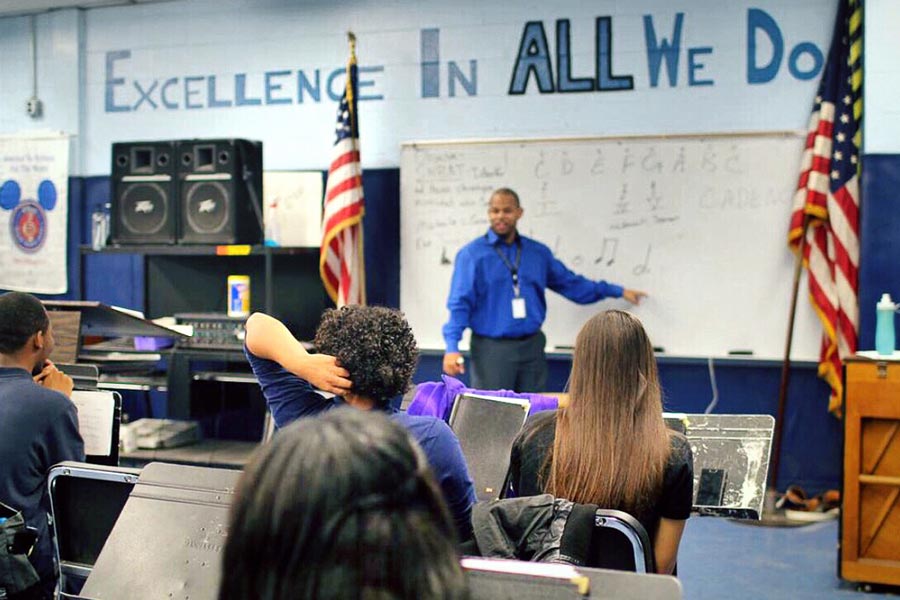Teacher Loan Forgiveness

Teachers rock. And we’re not just saying that. Educating future generations is a serious (and seriously awesome) task. Because teachers have such a vital purpose, it makes sense that they should have some perks. While a teacher’s salary isn’t always the most glorious, these deserving educators do catch a break when it comes to student loan forgiveness for teachers.
But here’s the thing about teacher loan forgiveness – it’s a tricky thing to navigate, with multiple options that have varying requirements.
There are three main programs that the Department of Education offers specifically for teachers: Teacher Loan Forgiveness, Public Service Loan Forgiveness, and Perkins Loan Teacher Cancellation and Discharge. Other forgiveness options include Income-Driven Repayment Forgiveness and state-based loan repayment programs.
Don’t get too worried about how to figure out which forgiveness option is best for you! We’ve put together a helpful guide to these student loan forgiveness options for teachers, complete with the pros and cons for each opportunity.
Let us hit you with some student loan forgiveness for teachers knowledge
Teacher Loan Forgiveness Program
If you teach full-time for five complete and consecutive academic years in a low-income school or educational service agency, the Teacher Loan Forgiveness Program could be just what you need.
Depending on the subject area you teach, you could have either $5,000 or $17,500 in student loan debt forgiven.
You’ll need to be a highly qualified teacher to qualify for this program.
What does a “highly qualified teacher” mean? The basic requirements to be a highly qualified teacher are that you have at least a bachelor’s degree; full state certification as a teacher; and not had your certification/licensure requirements waived on an emergency, temporary, or provisional basis.
There may be additional requirements depending on how new you are to the profession and what level of school you teach.
After you’ve completed the requirements (including the five consecutive years of teaching), you’ll need to complete the Teacher Loan Forgiveness Application and send it to your servicer(s). You will also need the chief administrative officer of your employer to complete the certification section of the application.
Pros of Teacher Loan Forgiveness
- Five years of teaching is a shorter time requirement compared to other forgiveness options.
- If you meet all the qualifications, you could be eligible to have up to $17,500 of your Direct Subsidized and Unsubsidized Loans and your Federal Stafford Loans forgiven.
- You can combine Teacher Loan Forgiveness with Public Service Loan Forgiveness or Income-Based Repayment Forgiveness.
- There’s no fee to apply for Teacher Loan Forgiveness.
- If you succeed in having student loans forgiven under this program, the forgiven loan amounts will not be considered taxable by the IRS.
- If you didn’t complete a full year of teaching, it may still be counted towards your five academic years, but only if it meets all the following requirements:
- You finished at least half of the academic year.
- Your employer deems that you’ve fulfilled your contract requirements for the academic year.
- You couldn’t complete the academic year because you either:
- Returned to postsecondary education in an area of study related to the performance of the teaching service described above.
- Had a condition covered under the Family and Medical Leave Act of 1993.
- Were ordered to active duty status for over 30 days as a member of a reserve component of the U.S. armed forces.
Cons of Teacher Loan Forgiveness
- The requirements are strict and some teachers have had difficulty qualifying.If you don’t meet the definition of a highly qualified teacher or if you’re a teacher in a public school that isn’t considered low-income, you may not qualify.
- It’s a less generous than the Public Service Loan Forgiveness Program as far as how much you can have forgiven.
- This program does not offer forgiveness for all types of loans, including PLUS loans for parents and graduate/professional students and Perkins loans.
- If you want to receive both Teacher Loan Forgiveness and PSLF, you won’t be able to receive them for the same period of teaching service. In other words, any monthly payments you make during the five years for Teacher Loan Forgiveness won’t count towards the required 120 monthly payments for PSLF.
- Did you spend time teaching through AmeriCorps? Unfortunately, that time can’t be counted towards the five years required for this program.
Public Service Loan Forgiveness (PSLF) Program
Public Service Loan Forgiveness is offered to those who work full-time in public service for qualifying employers, which includes teachers. If you meet all the requirements, you could have your federal student loans completely forgiven after 120 qualifying payments.
How to Qualify for PSLF
In order to get approval for this forgiveness, you’ll have to jump through a few hoops.
First, you’ll need to meet the following requirements:
- Make 120 qualifying payments on an income-driven repayment plan.
- Work full-time for a certain type of nonprofit or government agency for at least 10 years.
Have federal Direct Loans. - What constitutes a “qualifying payment?” That’s a full payment made no more than 15 days late. You must have also made these payments after Oct. 1, 2007.
You’ll need to submit the Employment Certification Form while making those 120 payments. You should submit this form annually and whenever you begin a job in public service or switch employers. Make sure the form is free of errors and that your employer signs the employment certification.
Once you’ve made those 120 qualifying payments, you’ll be able to complete your application for PSLF and submit it.
Need help figuring this PSLF thing out? The Department of Education has released a PSLF Help Tool. This tool can help you find out what you need to do to participate and fill out an Employment Certification Form partially to get you started.
Pros of PSLF
- This program offers more flexibility for applicants. You don’t need to be at a qualifying school to meet the requirements and you don’t need to be a teacher. For instance, librarians, principals, and janitors could all qualify for this program.
- If you are looking to take a different job outside of teaching, you could transition into a job with the government or a nonprofit without being disqualified from this program.
There’s no fee to apply for PSLF. - If you’re approved for PSLF and have loans forgiven under this program, the forgiven loan amounts will not be considered taxable by the IRS.
- You can combine PSLF with Teacher Loan Forgiveness.
Cons of PSLF
- This is one of the hardest forgiveness programs to qualify for thanks to all the strict requirements. In fact, it was recently discovered that 99 percent of those who applied to the PSLF program were rejected. But that doesn’t mean you can’t learn how to qualify for PSLF like a champion.
- The time required for this forgiveness is much longer than that of Teacher Loan Forgiveness.
- This is only available for federal Direct loans. However, you may be able to consolidate other federal student loans to qualify. Any private student loans will not be eligible though.
- If you’ve already had some of your student loans forgiven through Teacher Loan Forgiveness, you will not be able to count the time spent qualifying for that program towards PSLF.

Perkins Loan Teacher Cancellation
If you’re a teacher who meets the specific eligibility criteria, this program could forgive up to 100 percent of your federal Perkins loans.
How to Qualify for Perkins Loan Teacher Cancellation
You’ll need to work full-time at a qualifying nonprofit or public school in the Teacher Cancellation Low Income (TCLI) Directory.
However, you can also be eligible for cancellation if you’re a special education teacher or a teacher in the fields of math, science, foreign language, bilingual education, or any other subject that has a state-designated teacher shortage.
If you’re eligible for cancellation, this program forgives your loans in increments, including the interest that accrues during the year:
15 percent of your loan debt is canceled per year for the first and second years of service.
20 percent of your loan debt is canceled for the third and fourth years of service.
30 percent of your loan debt is canceled for the fifth year of service.
If you’re interested in applying for Perkins Cancellation, you’ll need to contact the school or schools where you got your Perkins loans. The school or the school’s Perkins loan servicer should be able to give you the forms and guidance you need to achieve cancellation.
Pros of Perkins Loan Teacher Cancellation
- If you have Perkins loans, you could have all that loan debt forgiven over five years through this program. That’s life-changing.
- The incremental nature of this program means that you don’t have to make it the entire five years to achieve some level of forgiveness.
- You also can qualify for deferment while you’re completing your teaching requirement for cancellation.
- While there are restrictions that dictate who can qualify for this program, its flexibility allows more applicants to qualify. In addition to teaching, other employment can qualify you for some or all cancellation depending on your loans, including firefighting, law enforcement, speech pathology, and nursing.
Cons of Perkins Loan Teacher Cancellation
- As the name implies, this cancellation/discharge option is only available for federal Perkins loans.
- You’ll need to check to see if your federal student loans are Perkins loans before you apply.
- Because the program only gives forgiveness in increments, you do need to have 5 years under your belt to get 100 percent forgiveness.
- Because schools were no longer able to make new Perkins Loans after Sept. 30, 2017, this program will eventually not be applicable to any borrowers.
Income-Driven Repayment (IDR) Forgiveness
If the above programs don’t work for you, you may want to explore income-based repayment forgiveness. It isn’t exclusively for teachers. However, it could easily benefit anyone who meets the qualifications.

How to Qualify for IDR Forgiveness
First, you’ll need to be eligible and signed up for one of the four income-driven repayment plans:
Revised Pay As You Earn (REPAYE) – Your payment is capped at 10 percent of your discretionary income. The REPAYE repayment term is 20 years for undergraduate loans and 25 years for graduate school loans.
Pay As You Earn (PAYE) – Your payment is 10 percent of your income but doesn’t exceed the payment you’d make on a standard plan. The PAYE repayment term is 20 years.
Income-Based Repayment (IBR) – Your payment is capped at 10 percent of your income. The IBR repayment term is 20 years if you borrowed after July 1, 2014, or 25 years if you borrowed before then.
Income-Contingent Repayment (ICR) – You will either pay 20 percent of your discretionary income or what you would pay with a standard plan but for 12 years, whichever is less. The ICR repayment term for the 20 percent option is 25 years.
Once you’ve selected your income-driven repayment plan, you’ll then make payments on your loans until the repayment term ends.
Once that repayment term ends, your remaining balance will be forgiven, no matter which plan you were on.
Pros of IDR Forgiveness
- Any periods in deferment or periods of repayment in other plans will count toward your repayment term time.
- You don’t have to apply for IDR forgiveness. Your servicer should let you know as you get close to the point of forgiveness.
- If you have a particularly large student loan debt balance, you could have a good chunk of it forgiven with IDR after the repayment term.
Cons of IDR Forgiveness
- To obtain forgiveness, you’ll need to stay on an IDR for the repayment term. This means filling out a recertification form every year to confirm that you’re still eligible for your repayment plan. If you are no longer eligible, you could lose your chance at forgiveness.
- Again, this option isn’t specifically a perk for teaching. It’s available to all federal student loan borrowers.
- The repayment terms are much longer than those of other forgiveness options. You may not have a balance left to forgive at the end of your repayment term, especially if your income rises.
The IRS will view any forgiven balance as canceled debt, which is taxable. So, expect a heftier tax bill for that tax year.
State-Sponsored Student Loan Forgiveness Programs
Some states go the extra mile for their teachers by offering state-based student loan forgiveness or repayment assistance programs.
Typically, these programs offer win-win scenarios for the states offering them; they function as a perk for teachers and they incentivize people to fill shortages in that state’s education system.
How to Qualify for State-Sponsored Forgiveness
There are so many state-sponsored student loan forgiveness programs that exist for teachers, all with their own qualifications.
If you want a place to start searching for these programs and their requirements, check out this helpful database from the American Federation of Teachers. You can use this tool to search for local forgiveness opportunities that might benefit you.
Pros of State-Sponsored Forgiveness
- You can stack some of these forgiveness programs with others, like PSLF or IDR.
- Depending on where you live, there could be much more forgiveness options available to you.
Cons of State-Sponsored Forgiveness
- If you’re interested in one of these programs, you’ll have to be a resident of the respective state.
- Most state-sponsored forgiveness programs cannot be overlapped with other programs. So, you wouldn’t be able to qualify for a state-sponsored program and simultaneously use that time to qualify for PSLF.
The Bottom Line of Student Loan Forgiveness for Teachers
Even if you’re planning to apply for student loan forgiveness or are waiting to hear back about your application, you’ll need to keep making loan payments. If you stop paying on your student loans, you could fall into the dreaded student loan default pit.
And if all these student loan forgiveness programs for teachers won’t cut it for you, don’t lose hope. Setting up a plan with one of our student loan consultants could help keep you on track.
Give us a call today to get started.

Let's Work Together!
Our consultants will provide a FREE CONSULTATION to guide you in the right direction towards relief from your student loan debt.